Organizational Behavior Report: LG's Culture, Motivation, and Teams
VerifiedAdded on 2023/01/19
|13
|3902
|23
Report
AI Summary
This report provides an in-depth analysis of LG's organizational behavior, examining how culture, politics, and power influence individual and team performance. It delves into LG's organizational culture, highlighting role culture, task culture, person culture, and power culture, and discusses how these aspects impact employee behavior. The report also explores various motivational theories, including content theories like Maslow's hierarchy of needs and process theories such as Vroom's expectancy theory, providing insights into how LG motivates its employees. Furthermore, it differentiates between effective and ineffective teams within the organization, outlining the characteristics that contribute to team success. The report concludes by defining key concepts and philosophies of organizational behavior, demonstrating how they contribute to achieving LG's goals and objectives. The report draws on various academic sources and models to support its analysis.
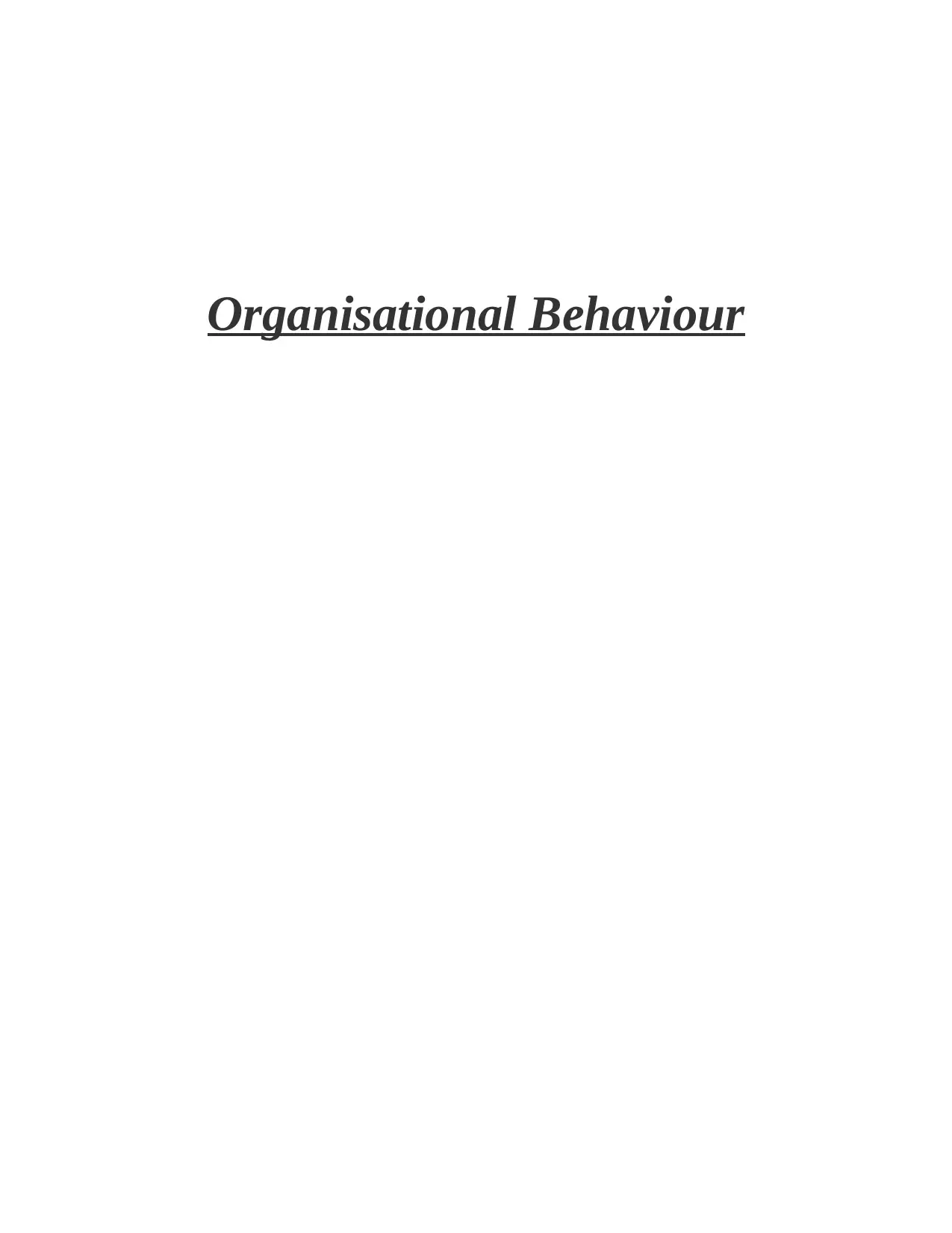
Organisational Behaviour
Paraphrase This Document
Need a fresh take? Get an instant paraphrase of this document with our AI Paraphraser
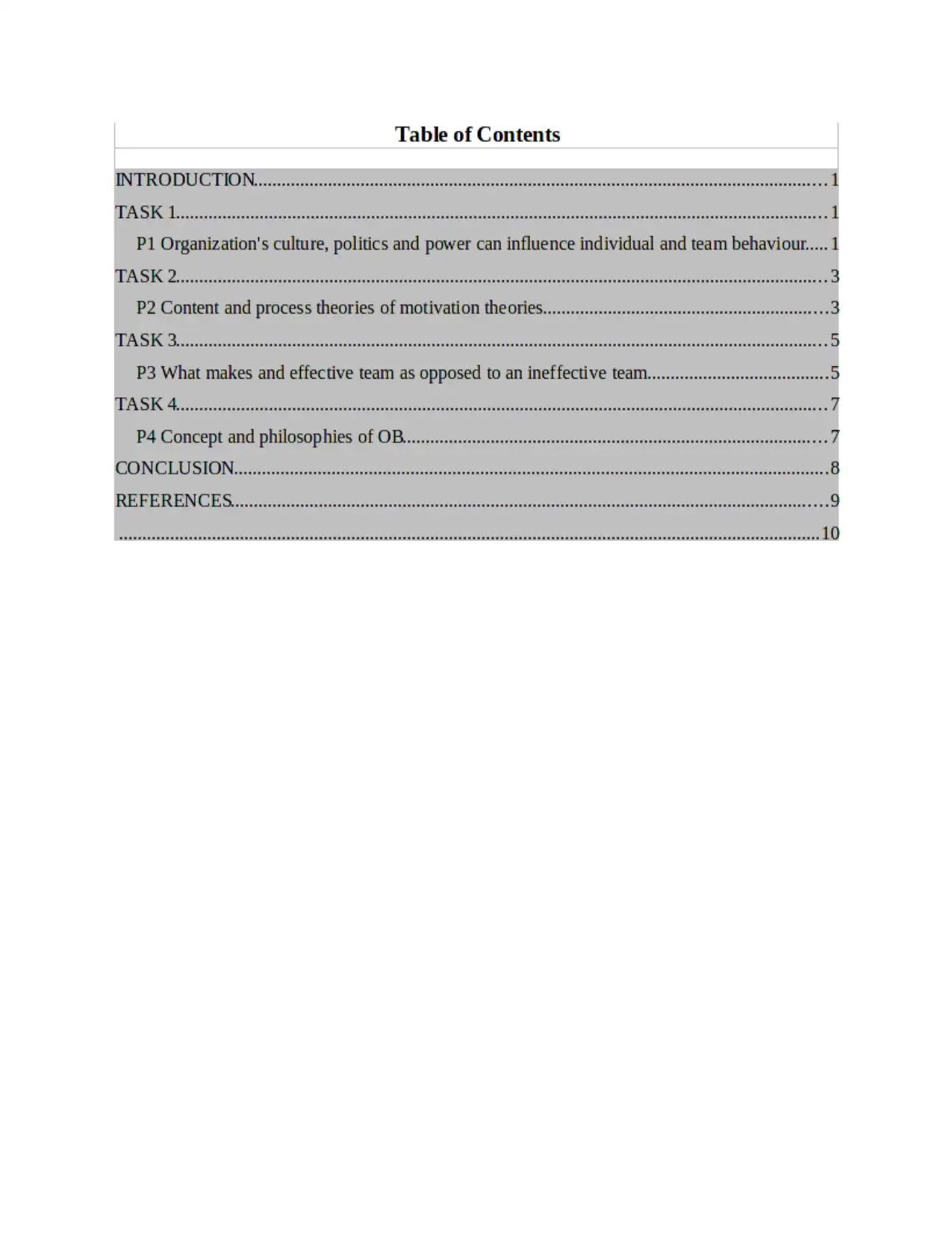

⊘ This is a preview!⊘
Do you want full access?
Subscribe today to unlock all pages.

Trusted by 1+ million students worldwide
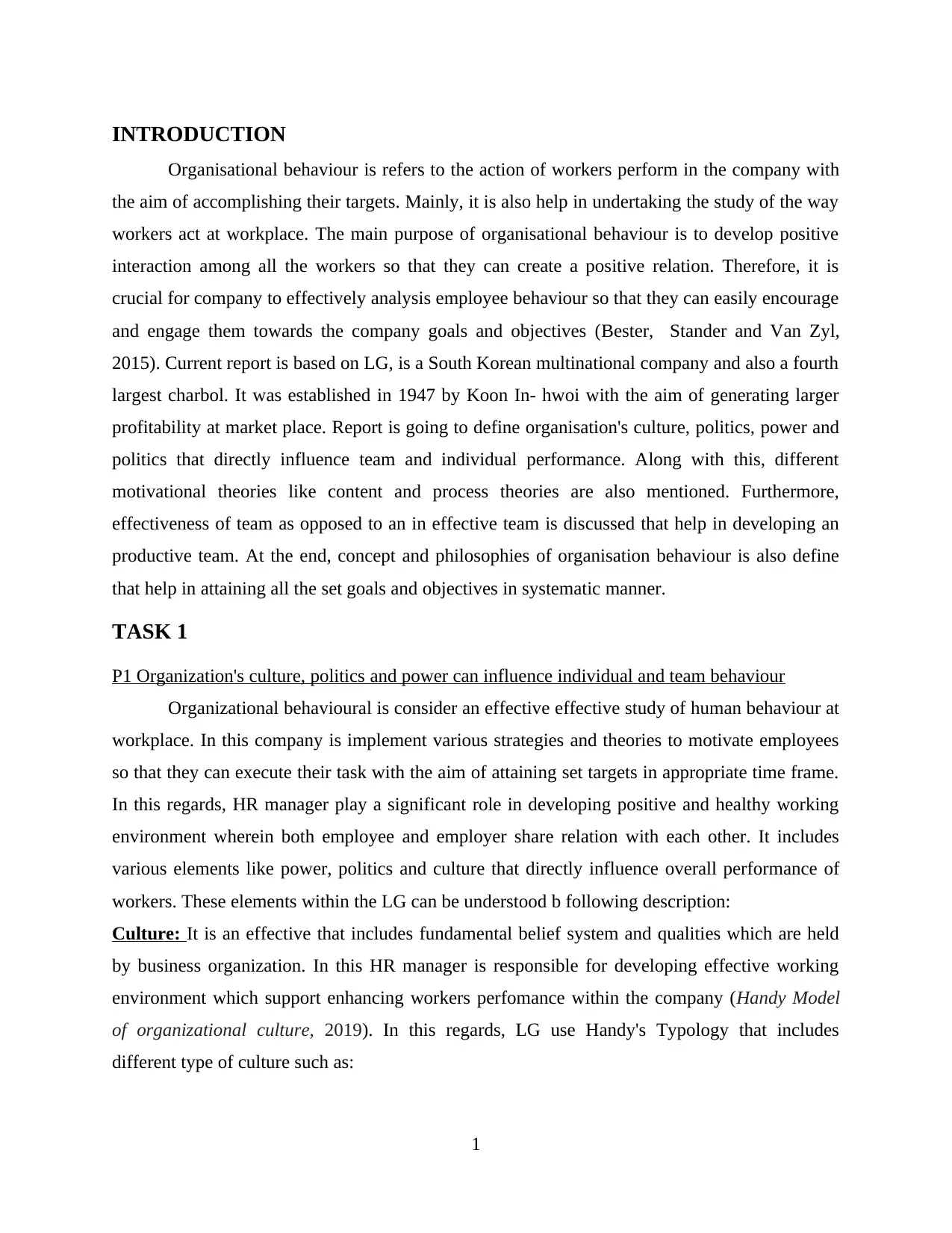
INTRODUCTION
Organisational behaviour is refers to the action of workers perform in the company with
the aim of accomplishing their targets. Mainly, it is also help in undertaking the study of the way
workers act at workplace. The main purpose of organisational behaviour is to develop positive
interaction among all the workers so that they can create a positive relation. Therefore, it is
crucial for company to effectively analysis employee behaviour so that they can easily encourage
and engage them towards the company goals and objectives (Bester, Stander and Van Zyl,
2015). Current report is based on LG, is a South Korean multinational company and also a fourth
largest charbol. It was established in 1947 by Koon In- hwoi with the aim of generating larger
profitability at market place. Report is going to define organisation's culture, politics, power and
politics that directly influence team and individual performance. Along with this, different
motivational theories like content and process theories are also mentioned. Furthermore,
effectiveness of team as opposed to an in effective team is discussed that help in developing an
productive team. At the end, concept and philosophies of organisation behaviour is also define
that help in attaining all the set goals and objectives in systematic manner.
TASK 1
P1 Organization's culture, politics and power can influence individual and team behaviour
Organizational behavioural is consider an effective effective study of human behaviour at
workplace. In this company is implement various strategies and theories to motivate employees
so that they can execute their task with the aim of attaining set targets in appropriate time frame.
In this regards, HR manager play a significant role in developing positive and healthy working
environment wherein both employee and employer share relation with each other. It includes
various elements like power, politics and culture that directly influence overall performance of
workers. These elements within the LG can be understood b following description:
Culture: It is an effective that includes fundamental belief system and qualities which are held
by business organization. In this HR manager is responsible for developing effective working
environment which support enhancing workers perfomance within the company (Handy Model
of organizational culture, 2019). In this regards, LG use Handy's Typology that includes
different type of culture such as:
1
Organisational behaviour is refers to the action of workers perform in the company with
the aim of accomplishing their targets. Mainly, it is also help in undertaking the study of the way
workers act at workplace. The main purpose of organisational behaviour is to develop positive
interaction among all the workers so that they can create a positive relation. Therefore, it is
crucial for company to effectively analysis employee behaviour so that they can easily encourage
and engage them towards the company goals and objectives (Bester, Stander and Van Zyl,
2015). Current report is based on LG, is a South Korean multinational company and also a fourth
largest charbol. It was established in 1947 by Koon In- hwoi with the aim of generating larger
profitability at market place. Report is going to define organisation's culture, politics, power and
politics that directly influence team and individual performance. Along with this, different
motivational theories like content and process theories are also mentioned. Furthermore,
effectiveness of team as opposed to an in effective team is discussed that help in developing an
productive team. At the end, concept and philosophies of organisation behaviour is also define
that help in attaining all the set goals and objectives in systematic manner.
TASK 1
P1 Organization's culture, politics and power can influence individual and team behaviour
Organizational behavioural is consider an effective effective study of human behaviour at
workplace. In this company is implement various strategies and theories to motivate employees
so that they can execute their task with the aim of attaining set targets in appropriate time frame.
In this regards, HR manager play a significant role in developing positive and healthy working
environment wherein both employee and employer share relation with each other. It includes
various elements like power, politics and culture that directly influence overall performance of
workers. These elements within the LG can be understood b following description:
Culture: It is an effective that includes fundamental belief system and qualities which are held
by business organization. In this HR manager is responsible for developing effective working
environment which support enhancing workers perfomance within the company (Handy Model
of organizational culture, 2019). In this regards, LG use Handy's Typology that includes
different type of culture such as:
1
Paraphrase This Document
Need a fresh take? Get an instant paraphrase of this document with our AI Paraphraser
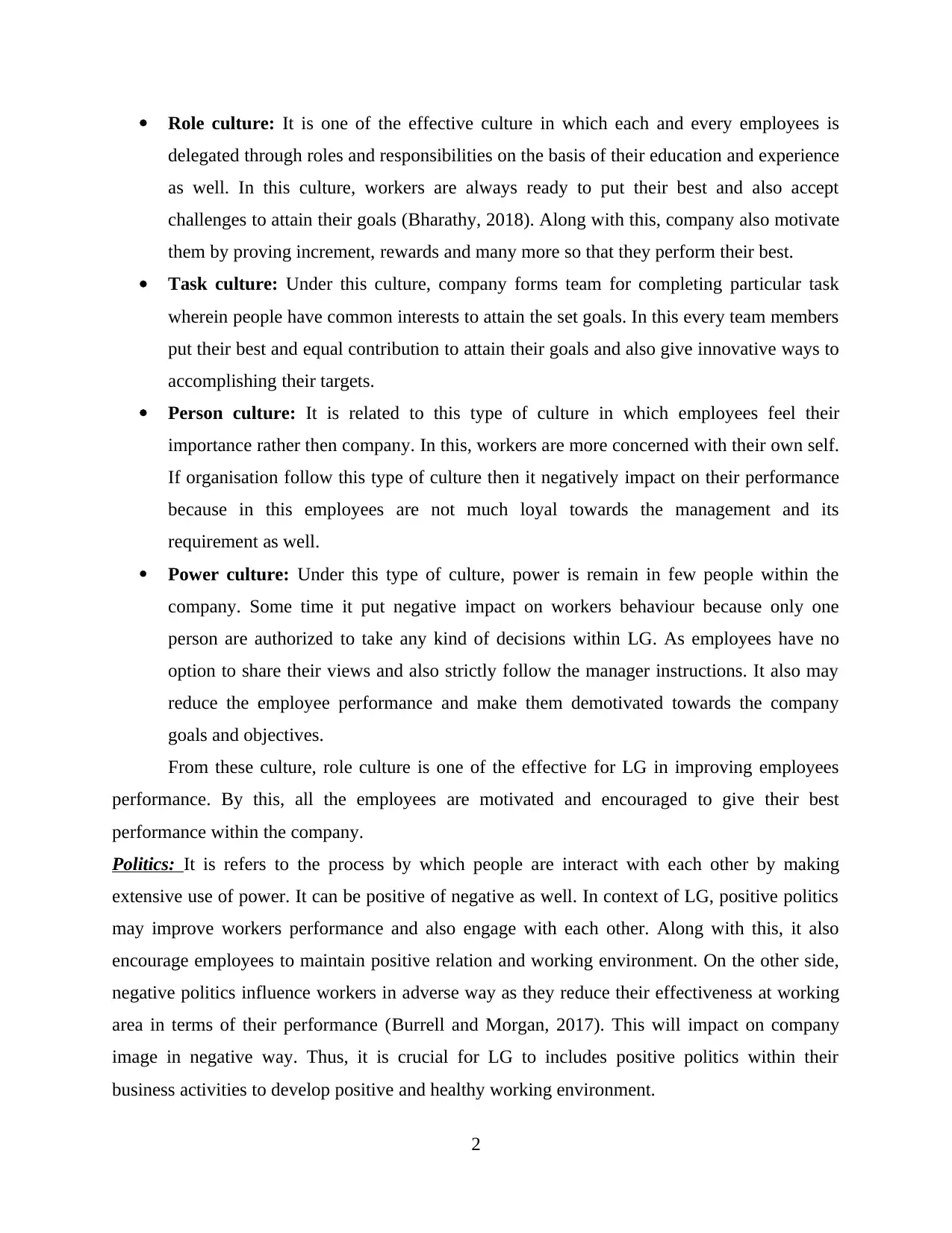
Role culture: It is one of the effective culture in which each and every employees is
delegated through roles and responsibilities on the basis of their education and experience
as well. In this culture, workers are always ready to put their best and also accept
challenges to attain their goals (Bharathy, 2018). Along with this, company also motivate
them by proving increment, rewards and many more so that they perform their best.
Task culture: Under this culture, company forms team for completing particular task
wherein people have common interests to attain the set goals. In this every team members
put their best and equal contribution to attain their goals and also give innovative ways to
accomplishing their targets.
Person culture: It is related to this type of culture in which employees feel their
importance rather then company. In this, workers are more concerned with their own self.
If organisation follow this type of culture then it negatively impact on their performance
because in this employees are not much loyal towards the management and its
requirement as well.
Power culture: Under this type of culture, power is remain in few people within the
company. Some time it put negative impact on workers behaviour because only one
person are authorized to take any kind of decisions within LG. As employees have no
option to share their views and also strictly follow the manager instructions. It also may
reduce the employee performance and make them demotivated towards the company
goals and objectives.
From these culture, role culture is one of the effective for LG in improving employees
performance. By this, all the employees are motivated and encouraged to give their best
performance within the company.
Politics: It is refers to the process by which people are interact with each other by making
extensive use of power. It can be positive of negative as well. In context of LG, positive politics
may improve workers performance and also engage with each other. Along with this, it also
encourage employees to maintain positive relation and working environment. On the other side,
negative politics influence workers in adverse way as they reduce their effectiveness at working
area in terms of their performance (Burrell and Morgan, 2017). This will impact on company
image in negative way. Thus, it is crucial for LG to includes positive politics within their
business activities to develop positive and healthy working environment.
2
delegated through roles and responsibilities on the basis of their education and experience
as well. In this culture, workers are always ready to put their best and also accept
challenges to attain their goals (Bharathy, 2018). Along with this, company also motivate
them by proving increment, rewards and many more so that they perform their best.
Task culture: Under this culture, company forms team for completing particular task
wherein people have common interests to attain the set goals. In this every team members
put their best and equal contribution to attain their goals and also give innovative ways to
accomplishing their targets.
Person culture: It is related to this type of culture in which employees feel their
importance rather then company. In this, workers are more concerned with their own self.
If organisation follow this type of culture then it negatively impact on their performance
because in this employees are not much loyal towards the management and its
requirement as well.
Power culture: Under this type of culture, power is remain in few people within the
company. Some time it put negative impact on workers behaviour because only one
person are authorized to take any kind of decisions within LG. As employees have no
option to share their views and also strictly follow the manager instructions. It also may
reduce the employee performance and make them demotivated towards the company
goals and objectives.
From these culture, role culture is one of the effective for LG in improving employees
performance. By this, all the employees are motivated and encouraged to give their best
performance within the company.
Politics: It is refers to the process by which people are interact with each other by making
extensive use of power. It can be positive of negative as well. In context of LG, positive politics
may improve workers performance and also engage with each other. Along with this, it also
encourage employees to maintain positive relation and working environment. On the other side,
negative politics influence workers in adverse way as they reduce their effectiveness at working
area in terms of their performance (Burrell and Morgan, 2017). This will impact on company
image in negative way. Thus, it is crucial for LG to includes positive politics within their
business activities to develop positive and healthy working environment.
2
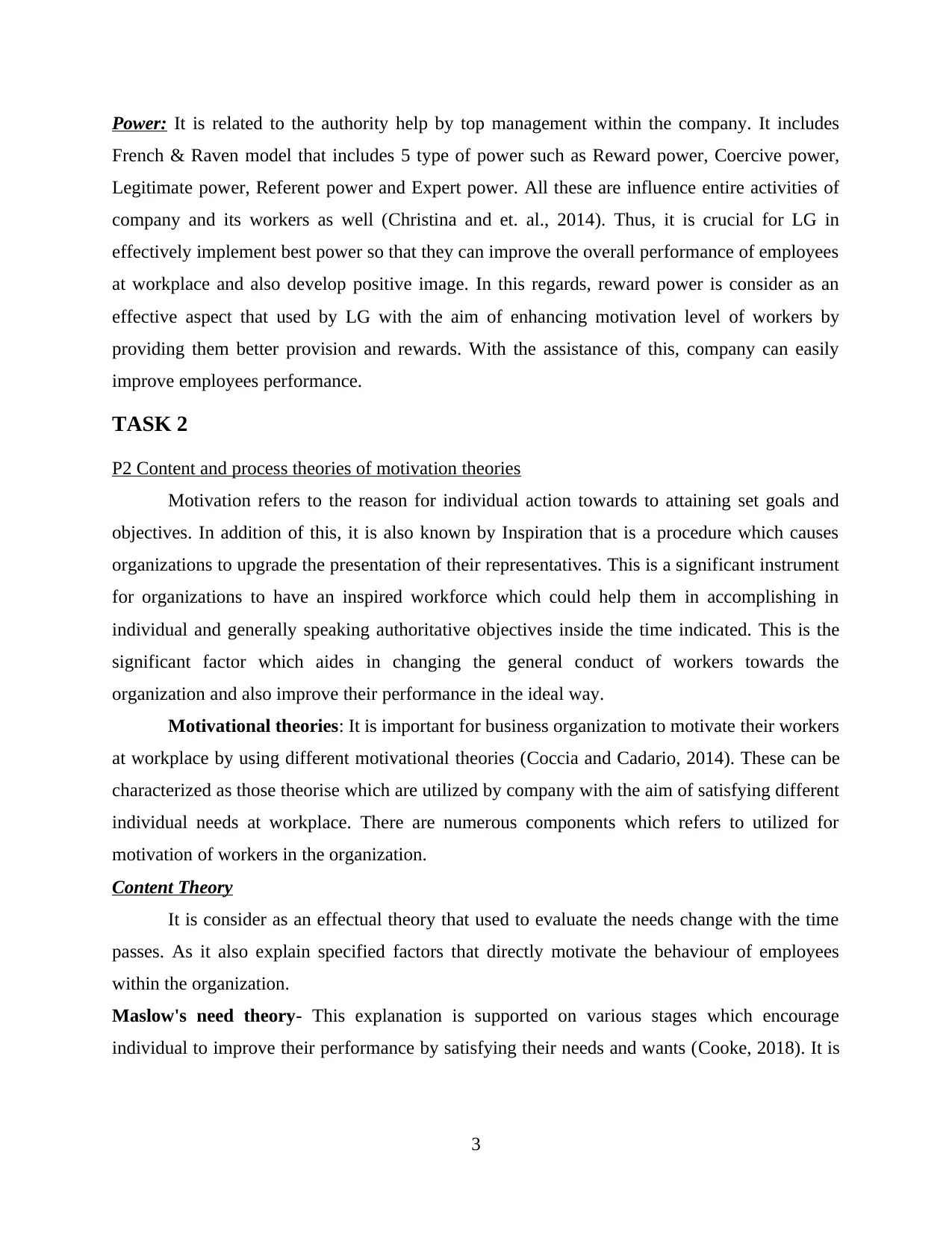
Power: It is related to the authority help by top management within the company. It includes
French & Raven model that includes 5 type of power such as Reward power, Coercive power,
Legitimate power, Referent power and Expert power. All these are influence entire activities of
company and its workers as well (Christina and et. al., 2014). Thus, it is crucial for LG in
effectively implement best power so that they can improve the overall performance of employees
at workplace and also develop positive image. In this regards, reward power is consider as an
effective aspect that used by LG with the aim of enhancing motivation level of workers by
providing them better provision and rewards. With the assistance of this, company can easily
improve employees performance.
TASK 2
P2 Content and process theories of motivation theories
Motivation refers to the reason for individual action towards to attaining set goals and
objectives. In addition of this, it is also known by Inspiration that is a procedure which causes
organizations to upgrade the presentation of their representatives. This is a significant instrument
for organizations to have an inspired workforce which could help them in accomplishing in
individual and generally speaking authoritative objectives inside the time indicated. This is the
significant factor which aides in changing the general conduct of workers towards the
organization and also improve their performance in the ideal way.
Motivational theories: It is important for business organization to motivate their workers
at workplace by using different motivational theories (Coccia and Cadario, 2014). These can be
characterized as those theorise which are utilized by company with the aim of satisfying different
individual needs at workplace. There are numerous components which refers to utilized for
motivation of workers in the organization.
Content Theory
It is consider as an effectual theory that used to evaluate the needs change with the time
passes. As it also explain specified factors that directly motivate the behaviour of employees
within the organization.
Maslow's need theory- This explanation is supported on various stages which encourage
individual to improve their performance by satisfying their needs and wants (Cooke, 2018). It is
3
French & Raven model that includes 5 type of power such as Reward power, Coercive power,
Legitimate power, Referent power and Expert power. All these are influence entire activities of
company and its workers as well (Christina and et. al., 2014). Thus, it is crucial for LG in
effectively implement best power so that they can improve the overall performance of employees
at workplace and also develop positive image. In this regards, reward power is consider as an
effective aspect that used by LG with the aim of enhancing motivation level of workers by
providing them better provision and rewards. With the assistance of this, company can easily
improve employees performance.
TASK 2
P2 Content and process theories of motivation theories
Motivation refers to the reason for individual action towards to attaining set goals and
objectives. In addition of this, it is also known by Inspiration that is a procedure which causes
organizations to upgrade the presentation of their representatives. This is a significant instrument
for organizations to have an inspired workforce which could help them in accomplishing in
individual and generally speaking authoritative objectives inside the time indicated. This is the
significant factor which aides in changing the general conduct of workers towards the
organization and also improve their performance in the ideal way.
Motivational theories: It is important for business organization to motivate their workers
at workplace by using different motivational theories (Coccia and Cadario, 2014). These can be
characterized as those theorise which are utilized by company with the aim of satisfying different
individual needs at workplace. There are numerous components which refers to utilized for
motivation of workers in the organization.
Content Theory
It is consider as an effectual theory that used to evaluate the needs change with the time
passes. As it also explain specified factors that directly motivate the behaviour of employees
within the organization.
Maslow's need theory- This explanation is supported on various stages which encourage
individual to improve their performance by satisfying their needs and wants (Cooke, 2018). It is
3
⊘ This is a preview!⊘
Do you want full access?
Subscribe today to unlock all pages.

Trusted by 1+ million students worldwide
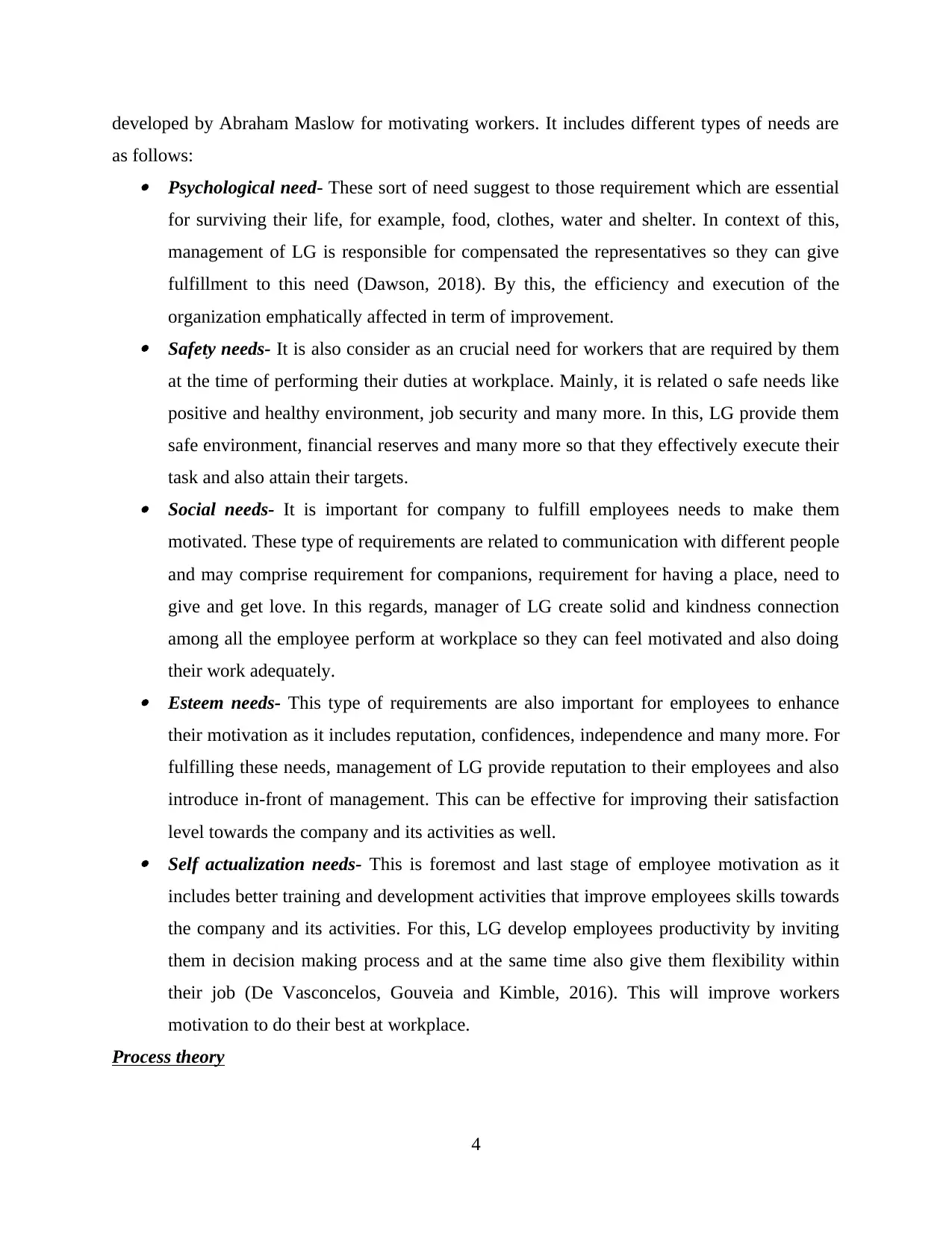
developed by Abraham Maslow for motivating workers. It includes different types of needs are
as follows: Psychological need- These sort of need suggest to those requirement which are essential
for surviving their life, for example, food, clothes, water and shelter. In context of this,
management of LG is responsible for compensated the representatives so they can give
fulfillment to this need (Dawson, 2018). By this, the efficiency and execution of the
organization emphatically affected in term of improvement. Safety needs- It is also consider as an crucial need for workers that are required by them
at the time of performing their duties at workplace. Mainly, it is related o safe needs like
positive and healthy environment, job security and many more. In this, LG provide them
safe environment, financial reserves and many more so that they effectively execute their
task and also attain their targets. Social needs- It is important for company to fulfill employees needs to make them
motivated. These type of requirements are related to communication with different people
and may comprise requirement for companions, requirement for having a place, need to
give and get love. In this regards, manager of LG create solid and kindness connection
among all the employee perform at workplace so they can feel motivated and also doing
their work adequately. Esteem needs- This type of requirements are also important for employees to enhance
their motivation as it includes reputation, confidences, independence and many more. For
fulfilling these needs, management of LG provide reputation to their employees and also
introduce in-front of management. This can be effective for improving their satisfaction
level towards the company and its activities as well. Self actualization needs- This is foremost and last stage of employee motivation as it
includes better training and development activities that improve employees skills towards
the company and its activities. For this, LG develop employees productivity by inviting
them in decision making process and at the same time also give them flexibility within
their job (De Vasconcelos, Gouveia and Kimble, 2016). This will improve workers
motivation to do their best at workplace.
Process theory
4
as follows: Psychological need- These sort of need suggest to those requirement which are essential
for surviving their life, for example, food, clothes, water and shelter. In context of this,
management of LG is responsible for compensated the representatives so they can give
fulfillment to this need (Dawson, 2018). By this, the efficiency and execution of the
organization emphatically affected in term of improvement. Safety needs- It is also consider as an crucial need for workers that are required by them
at the time of performing their duties at workplace. Mainly, it is related o safe needs like
positive and healthy environment, job security and many more. In this, LG provide them
safe environment, financial reserves and many more so that they effectively execute their
task and also attain their targets. Social needs- It is important for company to fulfill employees needs to make them
motivated. These type of requirements are related to communication with different people
and may comprise requirement for companions, requirement for having a place, need to
give and get love. In this regards, manager of LG create solid and kindness connection
among all the employee perform at workplace so they can feel motivated and also doing
their work adequately. Esteem needs- This type of requirements are also important for employees to enhance
their motivation as it includes reputation, confidences, independence and many more. For
fulfilling these needs, management of LG provide reputation to their employees and also
introduce in-front of management. This can be effective for improving their satisfaction
level towards the company and its activities as well. Self actualization needs- This is foremost and last stage of employee motivation as it
includes better training and development activities that improve employees skills towards
the company and its activities. For this, LG develop employees productivity by inviting
them in decision making process and at the same time also give them flexibility within
their job (De Vasconcelos, Gouveia and Kimble, 2016). This will improve workers
motivation to do their best at workplace.
Process theory
4
Paraphrase This Document
Need a fresh take? Get an instant paraphrase of this document with our AI Paraphraser
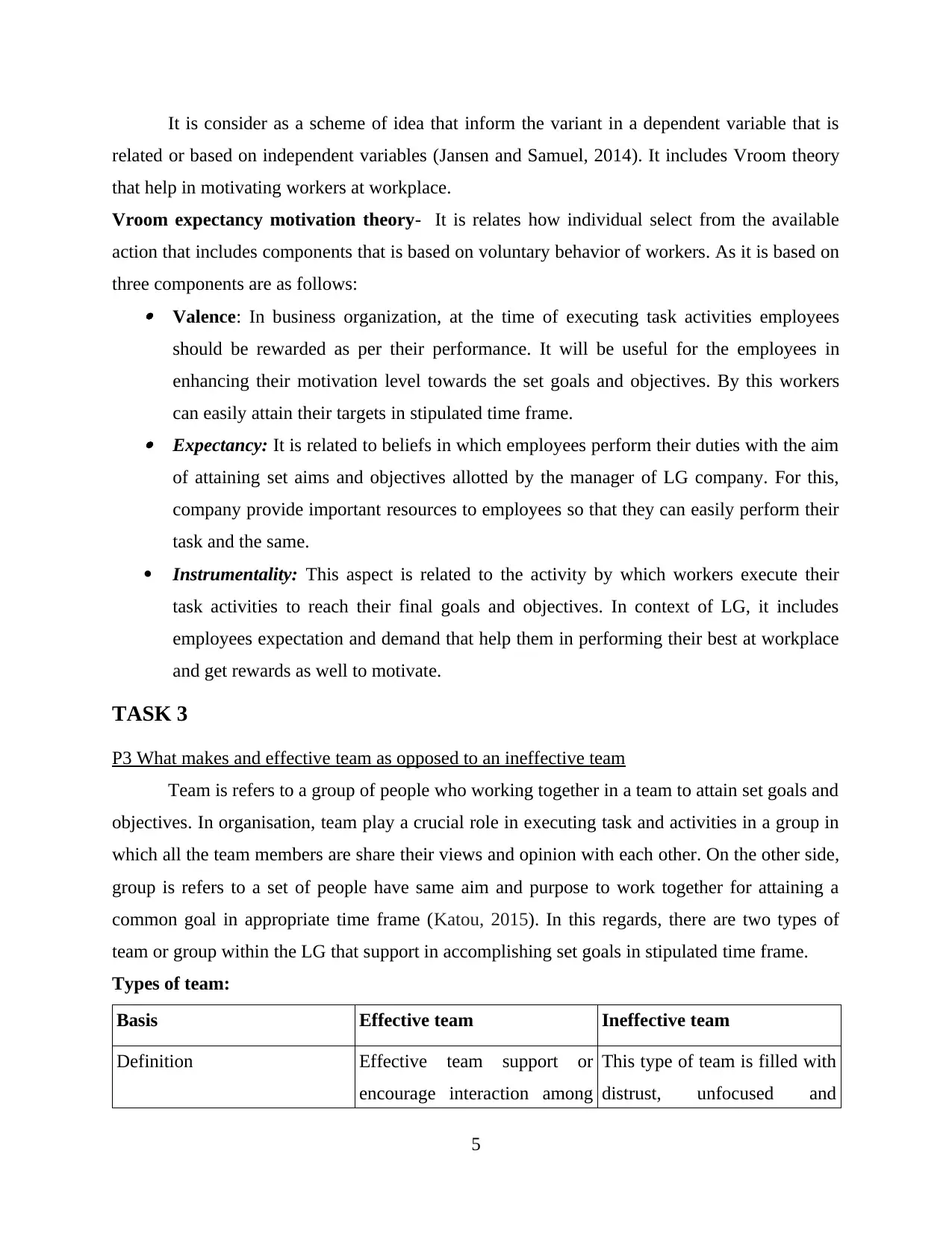
It is consider as a scheme of idea that inform the variant in a dependent variable that is
related or based on independent variables (Jansen and Samuel, 2014). It includes Vroom theory
that help in motivating workers at workplace.
Vroom expectancy motivation theory- It is relates how individual select from the available
action that includes components that is based on voluntary behavior of workers. As it is based on
three components are as follows: Valence: In business organization, at the time of executing task activities employees
should be rewarded as per their performance. It will be useful for the employees in
enhancing their motivation level towards the set goals and objectives. By this workers
can easily attain their targets in stipulated time frame. Expectancy: It is related to beliefs in which employees perform their duties with the aim
of attaining set aims and objectives allotted by the manager of LG company. For this,
company provide important resources to employees so that they can easily perform their
task and the same.
Instrumentality: This aspect is related to the activity by which workers execute their
task activities to reach their final goals and objectives. In context of LG, it includes
employees expectation and demand that help them in performing their best at workplace
and get rewards as well to motivate.
TASK 3
P3 What makes and effective team as opposed to an ineffective team
Team is refers to a group of people who working together in a team to attain set goals and
objectives. In organisation, team play a crucial role in executing task and activities in a group in
which all the team members are share their views and opinion with each other. On the other side,
group is refers to a set of people have same aim and purpose to work together for attaining a
common goal in appropriate time frame (Katou, 2015). In this regards, there are two types of
team or group within the LG that support in accomplishing set goals in stipulated time frame.
Types of team:
Basis Effective team Ineffective team
Definition Effective team support or
encourage interaction among
This type of team is filled with
distrust, unfocused and
5
related or based on independent variables (Jansen and Samuel, 2014). It includes Vroom theory
that help in motivating workers at workplace.
Vroom expectancy motivation theory- It is relates how individual select from the available
action that includes components that is based on voluntary behavior of workers. As it is based on
three components are as follows: Valence: In business organization, at the time of executing task activities employees
should be rewarded as per their performance. It will be useful for the employees in
enhancing their motivation level towards the set goals and objectives. By this workers
can easily attain their targets in stipulated time frame. Expectancy: It is related to beliefs in which employees perform their duties with the aim
of attaining set aims and objectives allotted by the manager of LG company. For this,
company provide important resources to employees so that they can easily perform their
task and the same.
Instrumentality: This aspect is related to the activity by which workers execute their
task activities to reach their final goals and objectives. In context of LG, it includes
employees expectation and demand that help them in performing their best at workplace
and get rewards as well to motivate.
TASK 3
P3 What makes and effective team as opposed to an ineffective team
Team is refers to a group of people who working together in a team to attain set goals and
objectives. In organisation, team play a crucial role in executing task and activities in a group in
which all the team members are share their views and opinion with each other. On the other side,
group is refers to a set of people have same aim and purpose to work together for attaining a
common goal in appropriate time frame (Katou, 2015). In this regards, there are two types of
team or group within the LG that support in accomplishing set goals in stipulated time frame.
Types of team:
Basis Effective team Ineffective team
Definition Effective team support or
encourage interaction among
This type of team is filled with
distrust, unfocused and
5
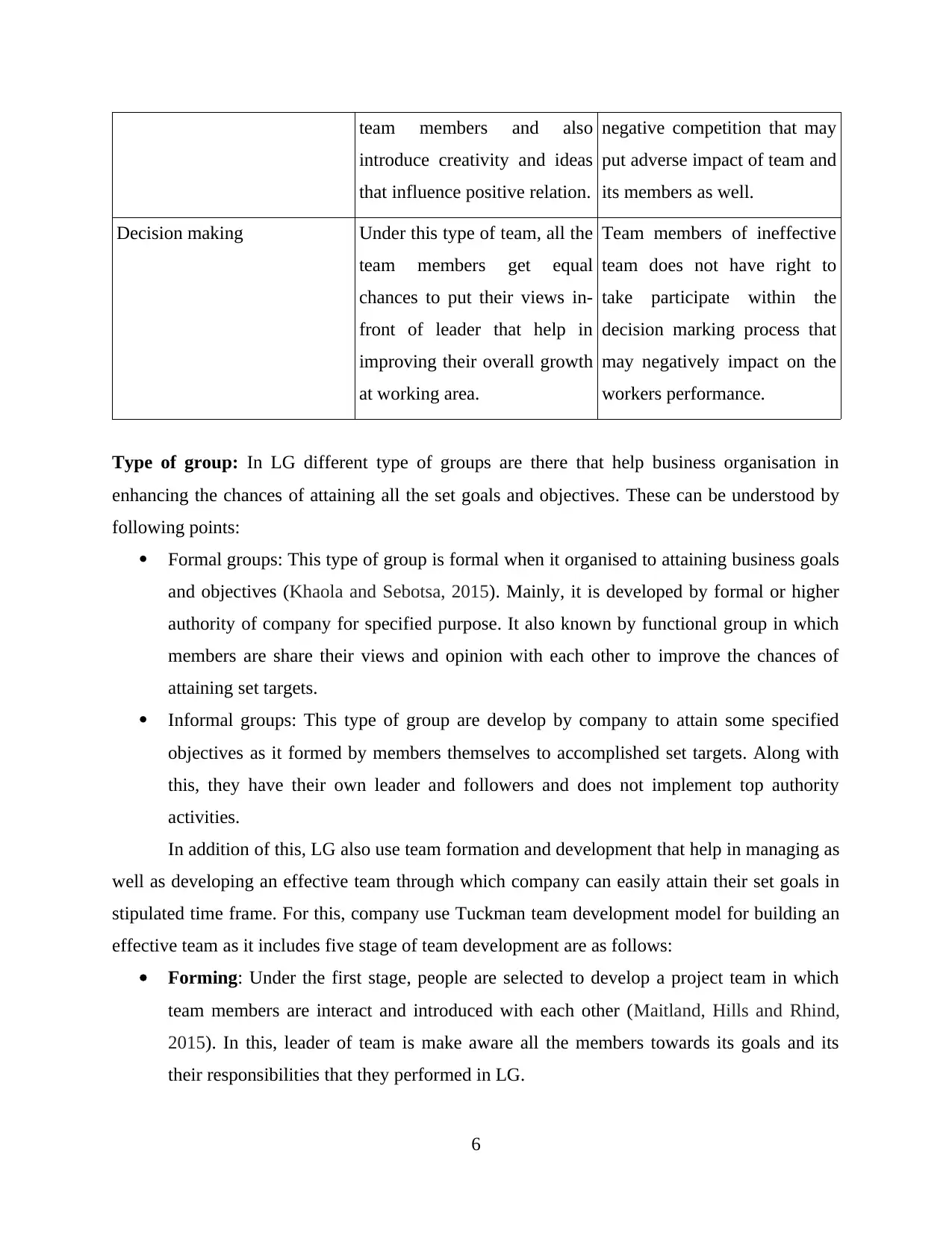
team members and also
introduce creativity and ideas
that influence positive relation.
negative competition that may
put adverse impact of team and
its members as well.
Decision making Under this type of team, all the
team members get equal
chances to put their views in-
front of leader that help in
improving their overall growth
at working area.
Team members of ineffective
team does not have right to
take participate within the
decision marking process that
may negatively impact on the
workers performance.
Type of group: In LG different type of groups are there that help business organisation in
enhancing the chances of attaining all the set goals and objectives. These can be understood by
following points:
Formal groups: This type of group is formal when it organised to attaining business goals
and objectives (Khaola and Sebotsa, 2015). Mainly, it is developed by formal or higher
authority of company for specified purpose. It also known by functional group in which
members are share their views and opinion with each other to improve the chances of
attaining set targets.
Informal groups: This type of group are develop by company to attain some specified
objectives as it formed by members themselves to accomplished set targets. Along with
this, they have their own leader and followers and does not implement top authority
activities.
In addition of this, LG also use team formation and development that help in managing as
well as developing an effective team through which company can easily attain their set goals in
stipulated time frame. For this, company use Tuckman team development model for building an
effective team as it includes five stage of team development are as follows:
Forming: Under the first stage, people are selected to develop a project team in which
team members are interact and introduced with each other (Maitland, Hills and Rhind,
2015). In this, leader of team is make aware all the members towards its goals and its
their responsibilities that they performed in LG.
6
introduce creativity and ideas
that influence positive relation.
negative competition that may
put adverse impact of team and
its members as well.
Decision making Under this type of team, all the
team members get equal
chances to put their views in-
front of leader that help in
improving their overall growth
at working area.
Team members of ineffective
team does not have right to
take participate within the
decision marking process that
may negatively impact on the
workers performance.
Type of group: In LG different type of groups are there that help business organisation in
enhancing the chances of attaining all the set goals and objectives. These can be understood by
following points:
Formal groups: This type of group is formal when it organised to attaining business goals
and objectives (Khaola and Sebotsa, 2015). Mainly, it is developed by formal or higher
authority of company for specified purpose. It also known by functional group in which
members are share their views and opinion with each other to improve the chances of
attaining set targets.
Informal groups: This type of group are develop by company to attain some specified
objectives as it formed by members themselves to accomplished set targets. Along with
this, they have their own leader and followers and does not implement top authority
activities.
In addition of this, LG also use team formation and development that help in managing as
well as developing an effective team through which company can easily attain their set goals in
stipulated time frame. For this, company use Tuckman team development model for building an
effective team as it includes five stage of team development are as follows:
Forming: Under the first stage, people are selected to develop a project team in which
team members are interact and introduced with each other (Maitland, Hills and Rhind,
2015). In this, leader of team is make aware all the members towards its goals and its
their responsibilities that they performed in LG.
6
⊘ This is a preview!⊘
Do you want full access?
Subscribe today to unlock all pages.

Trusted by 1+ million students worldwide
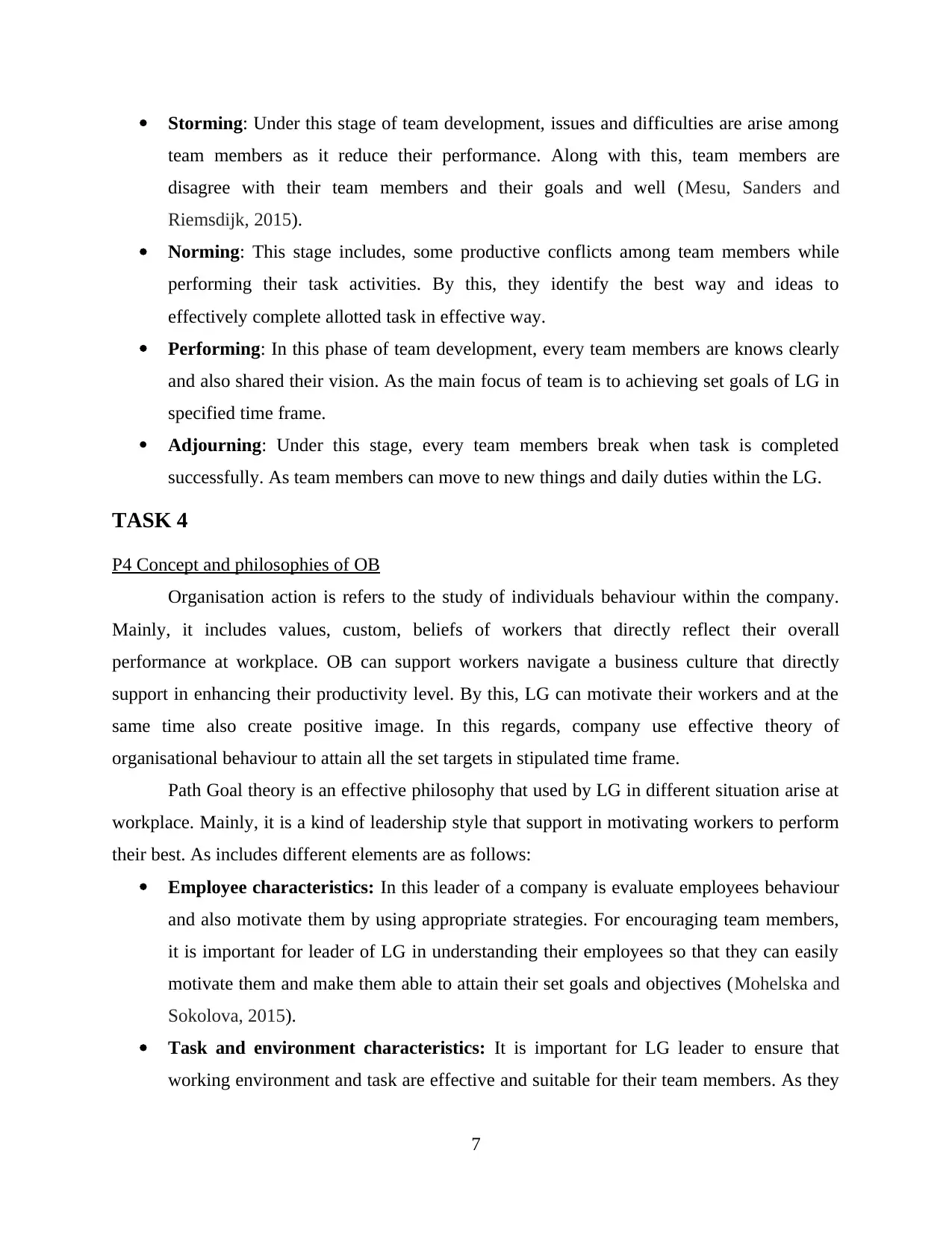
Storming: Under this stage of team development, issues and difficulties are arise among
team members as it reduce their performance. Along with this, team members are
disagree with their team members and their goals and well (Mesu, Sanders and
Riemsdijk, 2015).
Norming: This stage includes, some productive conflicts among team members while
performing their task activities. By this, they identify the best way and ideas to
effectively complete allotted task in effective way.
Performing: In this phase of team development, every team members are knows clearly
and also shared their vision. As the main focus of team is to achieving set goals of LG in
specified time frame.
Adjourning: Under this stage, every team members break when task is completed
successfully. As team members can move to new things and daily duties within the LG.
TASK 4
P4 Concept and philosophies of OB
Organisation action is refers to the study of individuals behaviour within the company.
Mainly, it includes values, custom, beliefs of workers that directly reflect their overall
performance at workplace. OB can support workers navigate a business culture that directly
support in enhancing their productivity level. By this, LG can motivate their workers and at the
same time also create positive image. In this regards, company use effective theory of
organisational behaviour to attain all the set targets in stipulated time frame.
Path Goal theory is an effective philosophy that used by LG in different situation arise at
workplace. Mainly, it is a kind of leadership style that support in motivating workers to perform
their best. As includes different elements are as follows:
Employee characteristics: In this leader of a company is evaluate employees behaviour
and also motivate them by using appropriate strategies. For encouraging team members,
it is important for leader of LG in understanding their employees so that they can easily
motivate them and make them able to attain their set goals and objectives (Mohelska and
Sokolova, 2015).
Task and environment characteristics: It is important for LG leader to ensure that
working environment and task are effective and suitable for their team members. As they
7
team members as it reduce their performance. Along with this, team members are
disagree with their team members and their goals and well (Mesu, Sanders and
Riemsdijk, 2015).
Norming: This stage includes, some productive conflicts among team members while
performing their task activities. By this, they identify the best way and ideas to
effectively complete allotted task in effective way.
Performing: In this phase of team development, every team members are knows clearly
and also shared their vision. As the main focus of team is to achieving set goals of LG in
specified time frame.
Adjourning: Under this stage, every team members break when task is completed
successfully. As team members can move to new things and daily duties within the LG.
TASK 4
P4 Concept and philosophies of OB
Organisation action is refers to the study of individuals behaviour within the company.
Mainly, it includes values, custom, beliefs of workers that directly reflect their overall
performance at workplace. OB can support workers navigate a business culture that directly
support in enhancing their productivity level. By this, LG can motivate their workers and at the
same time also create positive image. In this regards, company use effective theory of
organisational behaviour to attain all the set targets in stipulated time frame.
Path Goal theory is an effective philosophy that used by LG in different situation arise at
workplace. Mainly, it is a kind of leadership style that support in motivating workers to perform
their best. As includes different elements are as follows:
Employee characteristics: In this leader of a company is evaluate employees behaviour
and also motivate them by using appropriate strategies. For encouraging team members,
it is important for leader of LG in understanding their employees so that they can easily
motivate them and make them able to attain their set goals and objectives (Mohelska and
Sokolova, 2015).
Task and environment characteristics: It is important for LG leader to ensure that
working environment and task are effective and suitable for their team members. As they
7
Paraphrase This Document
Need a fresh take? Get an instant paraphrase of this document with our AI Paraphraser
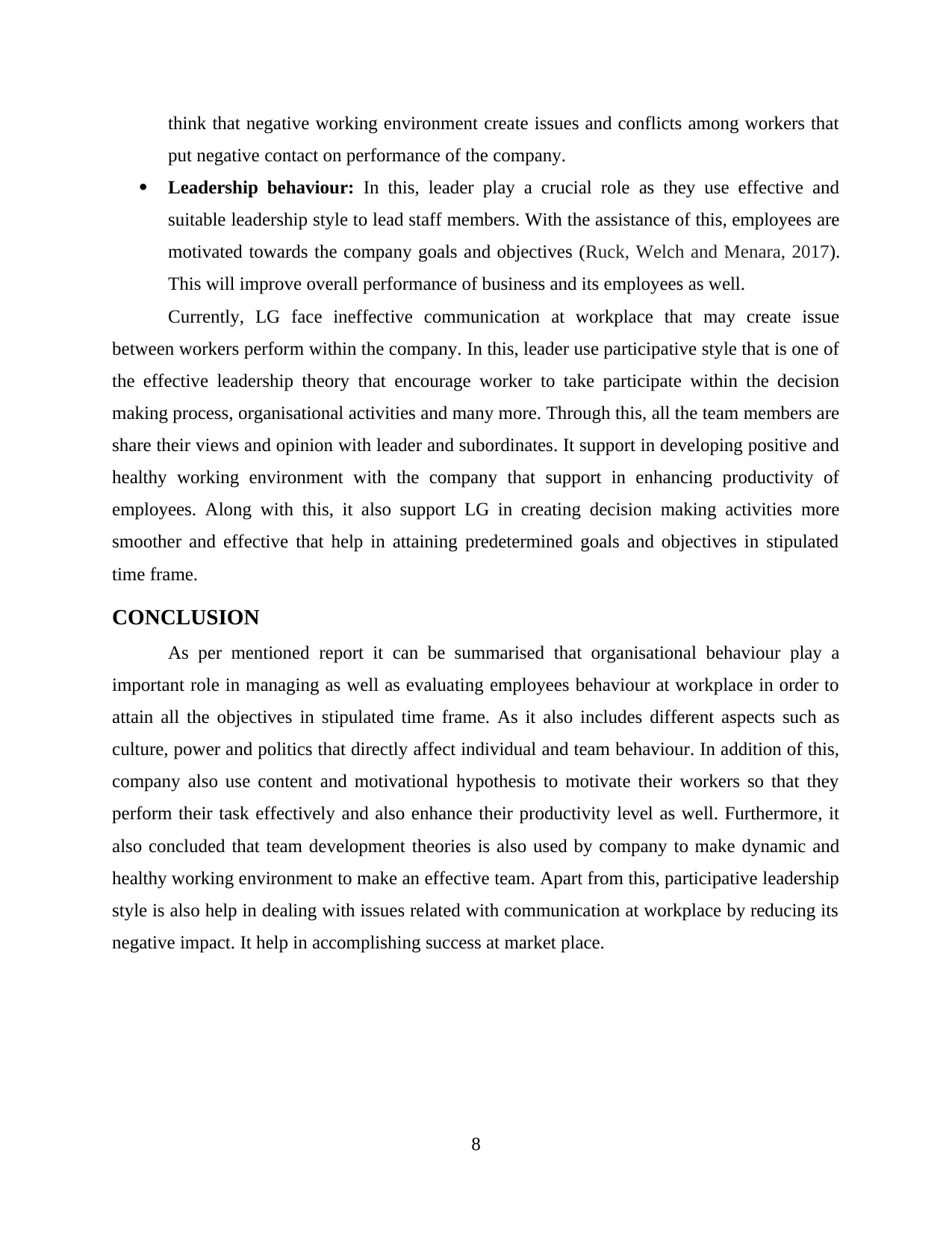
think that negative working environment create issues and conflicts among workers that
put negative contact on performance of the company.
Leadership behaviour: In this, leader play a crucial role as they use effective and
suitable leadership style to lead staff members. With the assistance of this, employees are
motivated towards the company goals and objectives (Ruck, Welch and Menara, 2017).
This will improve overall performance of business and its employees as well.
Currently, LG face ineffective communication at workplace that may create issue
between workers perform within the company. In this, leader use participative style that is one of
the effective leadership theory that encourage worker to take participate within the decision
making process, organisational activities and many more. Through this, all the team members are
share their views and opinion with leader and subordinates. It support in developing positive and
healthy working environment with the company that support in enhancing productivity of
employees. Along with this, it also support LG in creating decision making activities more
smoother and effective that help in attaining predetermined goals and objectives in stipulated
time frame.
CONCLUSION
As per mentioned report it can be summarised that organisational behaviour play a
important role in managing as well as evaluating employees behaviour at workplace in order to
attain all the objectives in stipulated time frame. As it also includes different aspects such as
culture, power and politics that directly affect individual and team behaviour. In addition of this,
company also use content and motivational hypothesis to motivate their workers so that they
perform their task effectively and also enhance their productivity level as well. Furthermore, it
also concluded that team development theories is also used by company to make dynamic and
healthy working environment to make an effective team. Apart from this, participative leadership
style is also help in dealing with issues related with communication at workplace by reducing its
negative impact. It help in accomplishing success at market place.
8
put negative contact on performance of the company.
Leadership behaviour: In this, leader play a crucial role as they use effective and
suitable leadership style to lead staff members. With the assistance of this, employees are
motivated towards the company goals and objectives (Ruck, Welch and Menara, 2017).
This will improve overall performance of business and its employees as well.
Currently, LG face ineffective communication at workplace that may create issue
between workers perform within the company. In this, leader use participative style that is one of
the effective leadership theory that encourage worker to take participate within the decision
making process, organisational activities and many more. Through this, all the team members are
share their views and opinion with leader and subordinates. It support in developing positive and
healthy working environment with the company that support in enhancing productivity of
employees. Along with this, it also support LG in creating decision making activities more
smoother and effective that help in attaining predetermined goals and objectives in stipulated
time frame.
CONCLUSION
As per mentioned report it can be summarised that organisational behaviour play a
important role in managing as well as evaluating employees behaviour at workplace in order to
attain all the objectives in stipulated time frame. As it also includes different aspects such as
culture, power and politics that directly affect individual and team behaviour. In addition of this,
company also use content and motivational hypothesis to motivate their workers so that they
perform their task effectively and also enhance their productivity level as well. Furthermore, it
also concluded that team development theories is also used by company to make dynamic and
healthy working environment to make an effective team. Apart from this, participative leadership
style is also help in dealing with issues related with communication at workplace by reducing its
negative impact. It help in accomplishing success at market place.
8
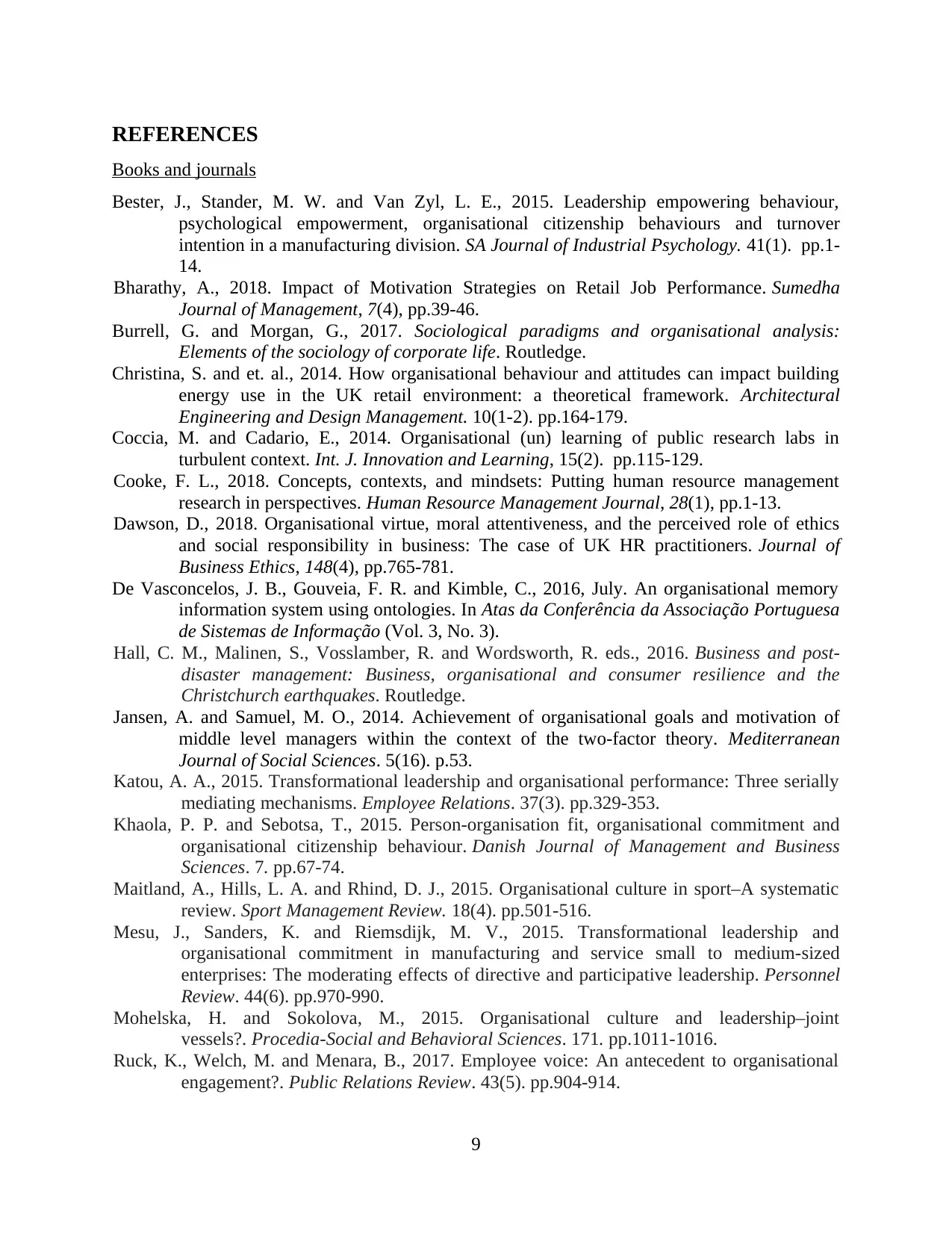
REFERENCES
Books and journals
Bester, J., Stander, M. W. and Van Zyl, L. E., 2015. Leadership empowering behaviour,
psychological empowerment, organisational citizenship behaviours and turnover
intention in a manufacturing division. SA Journal of Industrial Psychology. 41(1). pp.1-
14.
Bharathy, A., 2018. Impact of Motivation Strategies on Retail Job Performance. Sumedha
Journal of Management, 7(4), pp.39-46.
Burrell, G. and Morgan, G., 2017. Sociological paradigms and organisational analysis:
Elements of the sociology of corporate life. Routledge.
Christina, S. and et. al., 2014. How organisational behaviour and attitudes can impact building
energy use in the UK retail environment: a theoretical framework. Architectural
Engineering and Design Management. 10(1-2). pp.164-179.
Coccia, M. and Cadario, E., 2014. Organisational (un) learning of public research labs in
turbulent context. Int. J. Innovation and Learning, 15(2). pp.115-129.
Cooke, F. L., 2018. Concepts, contexts, and mindsets: Putting human resource management
research in perspectives. Human Resource Management Journal, 28(1), pp.1-13.
Dawson, D., 2018. Organisational virtue, moral attentiveness, and the perceived role of ethics
and social responsibility in business: The case of UK HR practitioners. Journal of
Business Ethics, 148(4), pp.765-781.
De Vasconcelos, J. B., Gouveia, F. R. and Kimble, C., 2016, July. An organisational memory
information system using ontologies. In Atas da Conferência da Associação Portuguesa
de Sistemas de Informação (Vol. 3, No. 3).
Hall, C. M., Malinen, S., Vosslamber, R. and Wordsworth, R. eds., 2016. Business and post-
disaster management: Business, organisational and consumer resilience and the
Christchurch earthquakes. Routledge.
Jansen, A. and Samuel, M. O., 2014. Achievement of organisational goals and motivation of
middle level managers within the context of the two-factor theory. Mediterranean
Journal of Social Sciences. 5(16). p.53.
Katou, A. A., 2015. Transformational leadership and organisational performance: Three serially
mediating mechanisms. Employee Relations. 37(3). pp.329-353.
Khaola, P. P. and Sebotsa, T., 2015. Person-organisation fit, organisational commitment and
organisational citizenship behaviour. Danish Journal of Management and Business
Sciences. 7. pp.67-74.
Maitland, A., Hills, L. A. and Rhind, D. J., 2015. Organisational culture in sport–A systematic
review. Sport Management Review. 18(4). pp.501-516.
Mesu, J., Sanders, K. and Riemsdijk, M. V., 2015. Transformational leadership and
organisational commitment in manufacturing and service small to medium-sized
enterprises: The moderating effects of directive and participative leadership. Personnel
Review. 44(6). pp.970-990.
Mohelska, H. and Sokolova, M., 2015. Organisational culture and leadership–joint
vessels?. Procedia-Social and Behavioral Sciences. 171. pp.1011-1016.
Ruck, K., Welch, M. and Menara, B., 2017. Employee voice: An antecedent to organisational
engagement?. Public Relations Review. 43(5). pp.904-914.
9
Books and journals
Bester, J., Stander, M. W. and Van Zyl, L. E., 2015. Leadership empowering behaviour,
psychological empowerment, organisational citizenship behaviours and turnover
intention in a manufacturing division. SA Journal of Industrial Psychology. 41(1). pp.1-
14.
Bharathy, A., 2018. Impact of Motivation Strategies on Retail Job Performance. Sumedha
Journal of Management, 7(4), pp.39-46.
Burrell, G. and Morgan, G., 2017. Sociological paradigms and organisational analysis:
Elements of the sociology of corporate life. Routledge.
Christina, S. and et. al., 2014. How organisational behaviour and attitudes can impact building
energy use in the UK retail environment: a theoretical framework. Architectural
Engineering and Design Management. 10(1-2). pp.164-179.
Coccia, M. and Cadario, E., 2014. Organisational (un) learning of public research labs in
turbulent context. Int. J. Innovation and Learning, 15(2). pp.115-129.
Cooke, F. L., 2018. Concepts, contexts, and mindsets: Putting human resource management
research in perspectives. Human Resource Management Journal, 28(1), pp.1-13.
Dawson, D., 2018. Organisational virtue, moral attentiveness, and the perceived role of ethics
and social responsibility in business: The case of UK HR practitioners. Journal of
Business Ethics, 148(4), pp.765-781.
De Vasconcelos, J. B., Gouveia, F. R. and Kimble, C., 2016, July. An organisational memory
information system using ontologies. In Atas da Conferência da Associação Portuguesa
de Sistemas de Informação (Vol. 3, No. 3).
Hall, C. M., Malinen, S., Vosslamber, R. and Wordsworth, R. eds., 2016. Business and post-
disaster management: Business, organisational and consumer resilience and the
Christchurch earthquakes. Routledge.
Jansen, A. and Samuel, M. O., 2014. Achievement of organisational goals and motivation of
middle level managers within the context of the two-factor theory. Mediterranean
Journal of Social Sciences. 5(16). p.53.
Katou, A. A., 2015. Transformational leadership and organisational performance: Three serially
mediating mechanisms. Employee Relations. 37(3). pp.329-353.
Khaola, P. P. and Sebotsa, T., 2015. Person-organisation fit, organisational commitment and
organisational citizenship behaviour. Danish Journal of Management and Business
Sciences. 7. pp.67-74.
Maitland, A., Hills, L. A. and Rhind, D. J., 2015. Organisational culture in sport–A systematic
review. Sport Management Review. 18(4). pp.501-516.
Mesu, J., Sanders, K. and Riemsdijk, M. V., 2015. Transformational leadership and
organisational commitment in manufacturing and service small to medium-sized
enterprises: The moderating effects of directive and participative leadership. Personnel
Review. 44(6). pp.970-990.
Mohelska, H. and Sokolova, M., 2015. Organisational culture and leadership–joint
vessels?. Procedia-Social and Behavioral Sciences. 171. pp.1011-1016.
Ruck, K., Welch, M. and Menara, B., 2017. Employee voice: An antecedent to organisational
engagement?. Public Relations Review. 43(5). pp.904-914.
9
⊘ This is a preview!⊘
Do you want full access?
Subscribe today to unlock all pages.

Trusted by 1+ million students worldwide
1 out of 13
Related Documents
Your All-in-One AI-Powered Toolkit for Academic Success.
+13062052269
info@desklib.com
Available 24*7 on WhatsApp / Email
![[object Object]](/_next/static/media/star-bottom.7253800d.svg)
Unlock your academic potential
Copyright © 2020–2025 A2Z Services. All Rights Reserved. Developed and managed by ZUCOL.





